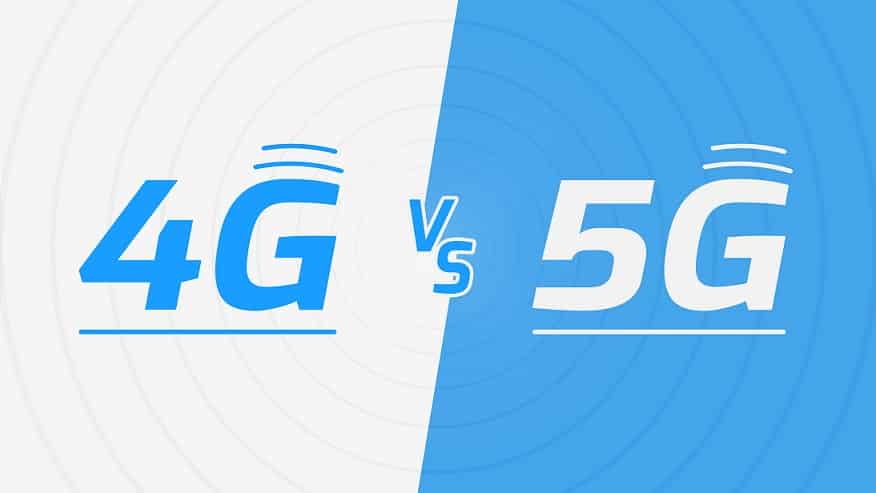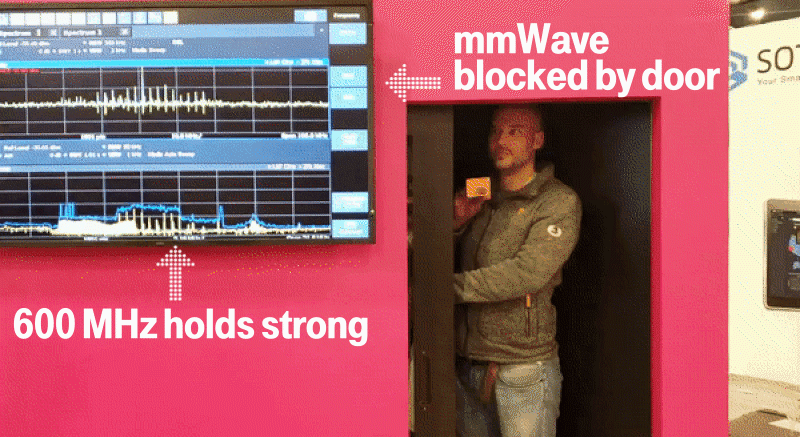
If you saw this headline in a search engine and stopped by to find out more about gravitational force equivalent aka acceleration, well, we’re a tech blog. As long as you’re here, read about the differences between 4G vs 5G and why your mobile online experience will soon be revolutionized by the emergence of The Next Great Technology — the Fifth Generation of Cellular Mobile Communication or 5G.
Back in 2016, the IAG waxed effusively of this progression looming on the wireless horizon, likening 4G to a single stop on a long journey. Now, the technology train is arriving at the next layover: 5G. This development of mobile communication promises even faster speeds and lower latencies, sure, but it also has profound implications for the Internet of Things (IoT) applications, such as “smart” cars, cities and buildings.
Yet, speaking of horizons, dark clouds loom for the widespread application of 5G. Part of the (over)hype is grandiose claims MNOs (we’re looking at you, Verizon and AT&T) blare while disregarding the limitations of millimeter (mm) Wave technology, which both Big Red and the Death Star utilize in their respective 5G rollouts. We’ll delve into this and other issues affecting the fast-approaching cybernetic “Age of Aquarius.”
The 4G Standard
MNOs must comply with the standards established by the International Telecommunications Union-Radio communications sector (ITU-R) for their network connectivity to be considered 4G, aka the International Mobile Telecommunications Advanced (IMT-Advanced) specification.
These standards specify that 4G networks must be based on IP packet switching (i.e., not circuit-switched) protocols. 4G networks must also employ Orthogonal frequency-division multiple access (OFDMA) multi-carrier transmission or other frequency domain equalization (FDE) techniques.
4G “peak” data speeds must be approximately 100 Mbps for a “highly mobile” (e.g., cellular) network and 1 Gbps for a “nomadic” (e.g., WiFi) network. Data handovers must be seamless across separate networks without data loss.
5G Standards? Stay Tuned
As of September 2019, finalized 5G standards have yet to be established. 5G’s essential functionalities and features will be settled in 2020 based on worldwide input from vendors (Ericsson, Qualcomm, Samsung, Huawei, et al), MNOs (AT&T, Verizon, Orange, et al) and standards organizations (ITU, the Internet Engineering Task Force [IETF] and the 3rd Generation Partnership Project [3GPP]).
5G latencies reckon to be at least 10x faster than 4G, which now average 50 ms. 5G speeds, depending upon bandwidth are 5-10x faster (sub-6 GHz) to 100x faster (30+ GHz) than 4G.
Differences Between 4G & 5G
Lots of improved technologies are combined to make the quantum leap from 4G to 5G. Below are some differences between the two.
For one, there’s the 5G-NR radio system. It isn’t compatible with 4G networks, which are backward compatible with 3G and even 2G. Part of 5G’s blazing speeds and ultra-low latencies comes from Massive MIMO, a technology utilizing many, many more antennas than 4G MIMO; 2G and 3G devices don’t use MIMO. 5G can transmit over much higher radio frequencies than 4G (a substantial fly in the ointment which we’ll address below).
The following analogy summarizes how 4G and 5G differ in radio coverage. Think of 4G as a floodlight, spreading illumination across a defined area but squandering light where nobody uses it. By contrast, a 5G signal is more precise. It uses advanced beamforming techniques to directionally target and efficiently (and exclusively) communicate with a destination device.
Too, by broadcasting across super high- (SHF) and extremely high-frequencies (EHF) bands of the radio spectrum (e.g., 28 GHz and above), 5G transports exponentially more data by using the higher data speeds these frequencies support. These band waves (at present) are much less congested and support much faster speeds and lower latencies than shorter bandwidths. While HF bands can be used for 5G, they can’t match the higher data speeds of SHF and EHF.
The advanced interfaces of 5G enable the operation of more devices within the same area compared with 4G. For example, 4G supports around 4,000 devices per km2 while 5G supports 1 million in the same space.
Another improvement 5G has over 4G is that 5G base stations operate at full-duplex, meaning they transmit and receive at the same time over the same frequency. By comparison, 4G alternates between Tx and Rx, which slows data speeds.
Slicing 4G vs 5G Networks
While overlooked by the average web user, 5G Network slicing is perhaps the most significant aspect of 5G evolution. This network architecture can support myriad SLRs over the same spectrum, much as the overlays of SDN and NFV applications do. Slicing creates virtual, separate end-to-end networks, leveraging the heretofore unrealized implementation of scalable and flexible services.
While carriers and end-users now take advantage of 4G network slicing, the sheer scale of 5G connectivity will dwarf the utility of 4G net slicing. It’s hard to imagine how a 4G network could automate—let alone efficiently—the various functions (e.g., robotics, sensors, etc.) needed for a shipping port or an automotive factory. It’s one reason why nobody talks about 4G networks supporting autonomous vehicles.
Network slicing—along with “LoRA“—will finally bring out the full potential of IoT and M2M communication across 5G LPWANs.
Have a gander at this vid produced by IEEE Spectrum in 2017: https://spectrum.ieee.org/video/telecom/wireless/everything-you-need-to-know-about-5g
4G vs 5G Latencies
We spoke of latencies above. For humans, the difference between 50 ms and 5 ms is virtually indistinguishable but for machines, it’s huge. Sure, enhanced VR applications and the ability to download a full-length UHD movie in seconds is neato stuff but ultra-low latencies have profound industrial impacts for the viability of autonomous vehicles (aka “automatic guided vehicles” or AGVs) and “massive-machine” type communications (“Industrial” IoT).
Research demonstrates that 5G latency speeds vary; bear in mind that a finalized 5G latency standard has yet to be established by the “Big 3”—ITU, IETF and the 3GPP. Users on a 4G network can expect latencies around 50 ms, which is pretty darn good. Unless you’re into cloud gaming (think Google Stadia), these intervals should suffice for your use.
According to lab trials conducted by the Global Mobile Suppliers Association (GSA) in 2018, 5G latencies ranged between <1 ms to 9-12 ms, with the vast majority between 1-2 ms. This is an incredibly tight window of variation; humans can’t use their innate senses to cognitively discern between these small differences.
Verizon claims that latencies will be “a millisecond on 5G” networks. Remember the overhype we mentioned at the outset? Get ready for misleading and outright marketing deception from MNOs like AT&T (You’ve heard of the Death Star’s “5G E“? Spoiler alert—it’s not 5G, just rebranded 4G ) and Big Red.
5G vs 4G Bandwidth Usage
For those who think 5G will be a panacea, we hate to rain on your parade but just as distance mars satellite network latency, bandwidth will limit 5G’s utility. T-Mobile CTO Neville Ray asserts that the use of mm-Wave spectrum (i.e, EHF bandwidths) used for 5G “will never materially scale beyond small pockets of 5G hotspots in dense urban environments.”
Ray’s point: the laws of physics dictate the utility of 5G mm-Wave technology. The ability of EHF radio waves to transport data is limited by distance (comparable to WiFi’s 801.11ad standard). Worse, glass, walls and even partially closed doors block EHF waves; shorter bands easily penetrate these materials.
See this .gif demonstrating Ray’s point:

Source: https://www.t-mobile.com/news/the-5g-status-quo-is-clearly-not-good-enough
This is the fly in the ointment; 5G’s white-hot speeds are possible by the propagation of the mm-wave spectrum. So, while 5G can be used across lower bandwidths, data speeds won’t be near as fast as the outrageous claims MNOs like Verizon and AT&T make. Moreover, data and user capacity will suffer as well. It’s telling that Apple reportedly won’t offer a 5G-compatible iPhone until late 2020 at the earliest.
Coda
Those who remember the 4G rollout (and its hyperbolic marketing) a decade ago recall that it took years for networks to reach the current level of coverage. Even now, only 70% of the U.S. has access to 4G speeds.
Given the sheer number of new radio base stations needed for 5G, expect decades before 5G matches the current coverage of 4G—if ever. The transformation to the widespread usage of 5G will be an unbelievably expensive undertaking, requiring massive buildouts of infrastructure. So, 4G will be with us for the foreseeable future.
Thankfully, LTE technology will continue to evolve, even if AT&T calls it “5G E.” So you can debark the technology train for a while; the 5G layover looks to be a long one.